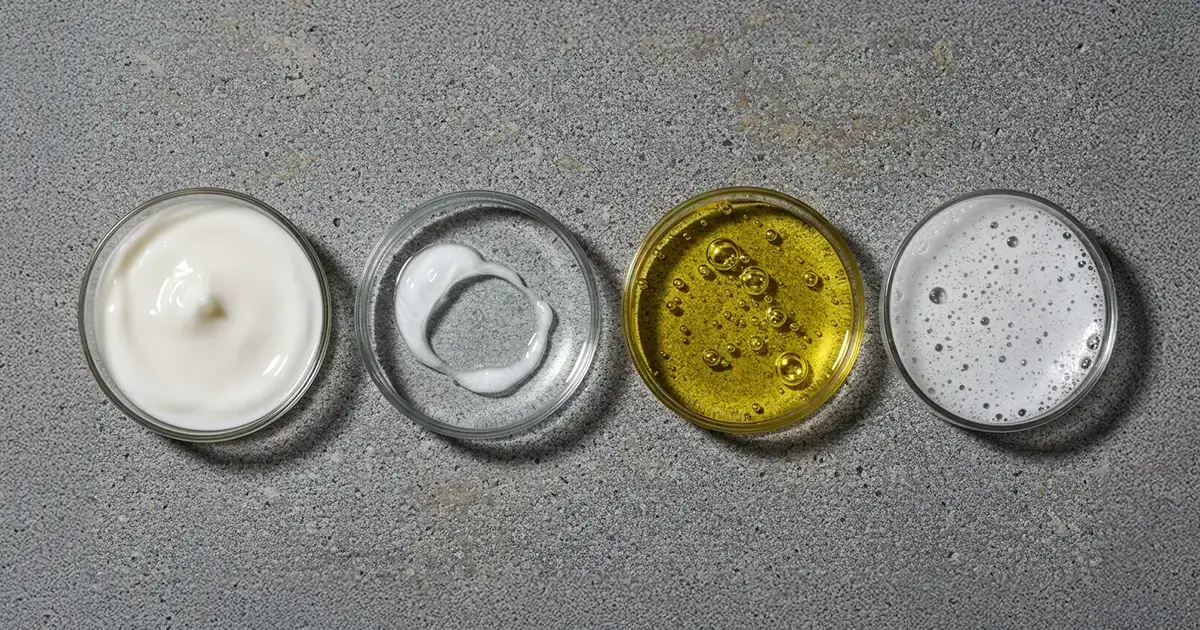Raise your hand if you have ever juggled three moisturizers because your cheeks peel while your nose shines like a disco ball. In this nine-minute read, I unpack every skin type, share easy at-home tests, and help you tailor a routine that feels like it was designed by your future self.
The Big Five Skin Types Explained
Dermatologists group skin into five core types - normal, oily, dry, combination, and sensitive - because patterns matter when you match ingredients to needs. This framework started in the 1910s, yet it survives modern scrutiny because it maps consistently to sebum levels, pore size, and barrier strength. It is not a label that locks you in forever, more of a snapshot you can revisit whenever life, hormones, or climate start meddling. I like checking mine as often as I switch out seasonal clothes, which keeps me from piling on products that solve yesterday's problems instead of today's.
Normal skin handles itself with quiet confidence: balanced sebum, even texture, and pores so small they rarely show up in selfies. Oily skin produces sebum like a well-funded factory, giving you that trademark midday sheen but also cushioning the barrier against dryness. Dry skin struggles with lipid production, leading to tightness, dull patches, and occasional flaking. Combination skin splits the difference - your T-zone acts like it runs a 24-hour diner while your cheeks write delicate poetry. Finally, sensitive skin is the drama queen of the group, flushing, stinging, or itching whenever the formula, temperature, or conversation shifts.
These definitions are helpful, but skin is alive, so expect cross-pollination. I can be oily in July, normal in September, and a delicate snowflake by January. Track subtle changes with a skin diary: jot observations after cleansing, before makeup, and at bedtime. Over a month, patterns emerge, and patterns are gold when you want to shop smart rather than gamble at the beauty aisle.
- Normal: Few visible pores, smooth texture, minimal breakouts.
- Oily: Enlarged pores, frequent shine, makeup slides by noon.
- Dry: Feels tight, prone to flaking, fine lines appear earlier.
- Combination: Oily in the central zone, normal to dry elsewhere.
- Sensitive: Redness, tingling, reacts quickly to fragrance or heat.
Why Skin Type Matters for Your Daily Routine
Your skin barrier resembles brickwork: corneocytes form the bricks, lipids act as mortar, and the whole wall keeps water in while fending irritants off. A 2023 Harvard Medical School study showed oily skin retains moisture roughly 15 % longer than dry skin because its lipid mortar stays softer. Dry or sensitive skin has fewer lipids, so water evaporates faster, and the barrier cracks sooner, inviting redness and itching. Matching products to type, therefore, is not vanity, it is first-aid for your outermost organ.
Ingredient families behave like kitchen spices, each enhancing or muting a specific trait. Hyaluronic acid attracts water, niacinamide shrinks the look of pores, and ceramides patch microscopic cracks. Oily skin benefits from lightweight humectants and gentle exfoliants such as salicylic acid, which dive into sebum-filled pores rather than sitting on the surface. Dry skin loves occlusive agents like shea butter that slow evaporation and fill lipid gaps. Sensitive skin has a crush on centella asiatica, colloidal oatmeal, and panthenol, all of which calm redness without suppressing your natural immune response.
One clever tweak is adjusting cleanser pH. The acid mantle prefers 4.5–5.5; traditional bar soap can shoot that to 9, leaving the barrier open and stressed. Mayo Clinic dermatologists recommend switching to mildly acidic cleansers, especially for dry or sensitive types, because it preserves enzymatic activity that keeps surface cells healthy.
Barrier Health and Lifestyle
Sleep, diet, and stress hormones change your skin type temporarily. A week of short nights bumps cortisol, which can thicken sebum and push normal skin toward oily. High-altitude travel reduces humidity, nudging combination skin to act dry. Log lifestyle factors next to skin notes; when flare-ups happen, you will have receipts rather than mysteries.
How to Test and Track Your Skin Type at Home
Cleanse your face, skip all products, then set a one-hour timer. This is the bare-face test, and it is more revealing than gossip at brunch. After sixty minutes, press blotting sheets onto your T-zone and cheeks. Hold them toward a light source: translucent spots confirm oil, opaque spots suggest dryness, and mixed results tell a combination tale.
Next, lean into a window with indirect light and inspect texture using a hand mirror. Look for flakiness, pore size, and any redness clusters near the nostrils or chin. Sensitive skin often hides on the cheeks, showing faint capillaries or pink freckles even without obvious irritation. Take a quick photo; comparing snapshots beats relying on memory, which is notoriously biased on sleepy mornings.
Finally, check how your skin feels after another hour - no touching allowed. If it pulls when you smile, dryness is evident. If oil beads at the brow, your sebaceous glands are lively. Tingling or warmth may signal sensitivity. Record all three checkpoints in a notes app or spreadsheet. This habit is as dull as balancing a checkbook, yet it pays off in product savings and fewer emergency patch tests.
- Run the test quarterly, or after hormonal changes like switching birth control.
- Note climate data: humidity, temperature, and UV index explain sudden shifts.
- Introduce one new product at a time, so the results stay interpretable.
Building a Customized Routine for Every Skin Type
Let us translate diagnosis into action. Start with a low-pH cleanser matched to oil output: gel for oily or combination, cream for dry or sensitive, and a gentle foaming hybrid for normal. Follow with a hydrating toner packed with humectants like glycerin. Serums come next - this is where you get personal. I reach for niacinamide in humid months, then swap to a peptide-rich formula when heaters dry the air.
Moisturizer should reflect your climate and oil levels, not social media trends. Oily skin may thrive on lightweight lotions spiked with green tea or zinc PCA. Dry skin needs emollients such as squalane or jojoba oil over a ceramide base. Combination skin can “cocktail” by dotting a richer cream on cheeks and a gel-cream on the T-zone. Sensitive skin stays loyal to minimal-ingredient formulas, always fragrance-free.
Sunscreen is the non-negotiable final step. Choose broad-spectrum SPF 30 or higher, and reapply every two hours of daylight exposure. Chemical filters sink in invisibly on oily skin, while mineral filters soothe sensitive faces by reflecting UV rather than absorbing it. Keep a mini tube in your bag and another at your desk; convenience triples compliance.
Active Ingredients Cheat Sheet
- Salicylic acid (BHA): Oil-soluble exfoliant for congested pores.
- Lactic acid (AHA): Gentle resurfacing for dry or dull skin.
- Azelaic acid: Calming agent that also brightens post-blemish marks.
- Retinol: Speeds cell turnover, use at night with gradual build-up.
- Ceramides: Barrier repair heroes for every skin type.
Introduce actives slowly. Patch-test on the jawline for three nights before sending them to the full face. Increase frequency only if redness stays away. Think of actives as spicy food: tasty in moderation, painful if piled on recklessly.
Seasonal Tweaks
Summer calls for oil-free hydrators and a lightweight antioxidant serum under sunscreen, because UV plus pollution creates free radicals that accelerate fine lines. Autumn is perfect for re-introducing gentle chemical exfoliants, sloughing off sunscreen buildup and sweat residues. Winter rewards thicker moisture barriers: switch to an occlusive night cream and deploy a humidifier in rooms with central heating. Spring, breezy and hopeful, lets you recalibrate, easing off occlusives but keeping barrier support until temperature swings stabilize.
FAQ
How often should I reassess my skin type?
Every three months is ideal, but also after life events like pregnancy, long-haul flights, or switching medications, because hormones and environment influence sebum and sensitivity.
Can I be oily and dehydrated at the same time?
Absolutely, dehydration refers to water content, not oil, so oily skin can still feel tight if the barrier leaks moisture.
Do I need different cleansers for morning and night?
Only if your evening routine involves heavy sunscreen or makeup; otherwise, a single low-pH cleanser works for both sessions.
Is toner outdated in modern routines?
No, hydrating or pH-balancing toners support barrier health, especially for dry or sensitive skin, though astringent alcohol toners are best left in the 1990s.
What is the safest exfoliation schedule for sensitive skin?
Start with a mild PHA or lactic acid once weekly, monitor for redness, and increase to twice weekly only if your skin stays calm for a full month.
Conclusion
Your skin type is a living data point rather than a permanent verdict, so treat assessment as an ongoing conversation. Choose products that cooperate with your current needs, track changes like a curious scientist, and adjust formulas just as you would adjust clothing through the seasons.
Tell me in the comments which test surprised you most, or share the ingredient combo that finally made peace with your barrier. See you in the next post - until then, take good care of your skin!


Comments (0)
No comments yet - be the first to share your thoughts!
Leave a Reply
Your email address will not be published. Required fields are marked *